2017-04-27 - Nº 104
Editorial
Esta é a Newsletter Nº 104 que se apresenta com o mesmo formato que as anteriores. Se gostar da Newsletter partilhe-a!
Todas as Newsletters encontram-se indexadas no link.
Esta Newsletter tem os seguintes tópicos:
Faz hoje anos que nascia em 1896 Wallace Carothers. Este químico Norte-Americano ficou conhecido pela sua invenção do neopreno e do nylon. Faz também anos Samuel Morse. Este Norte-americano, nascido em 1791 no estado do Massachusetts ficou conhecido pela invenção do sistema de codificação Morse. O código Morse foi desenvolvido de modo a que os operadores pudessem traduzir as indentações marcadas na fita de papel em mensagens de texto. No seu código mais antigo, Morse tinha planeado transmitir apenas números e usar um livro de códigos para procurar cada palavra de acordo com o número que tinha sido enviado. Entretanto, o código foi expandido posteriormente por Alfred Vail em 1840 para incluir letras e caracteres especiais, assim que poderia ser usado mais geralmente.
Esta semana ficámos a conhecer o projecto apoiado pelo fundador da Google - Larry Page - o Kitty. Trata-se de um veiculo voador movido a energia eléctrica. A China está em conversações com a agência espacial europeia para a criação de um posto Lunar. Esta semana também ficámos a conhecer o novo sistema de pneus sem ar da Bridgestone que irá equipar bicicletas a partir de 2019. Hoje também é noticia a sonda Cassini que está nas orbitas finais a volta de Saturno e continua a enviar informação e imagens muito interessantes deste planeta e dos seus anéis.
Na Newsletter desta semana apresentamos diversos projetos de maker assim como um modelo 3D que poderá ser útil.
 João Alves ([email protected])
João Alves ([email protected])
O conteúdo da Newsletter encontra-se sob a licença  Creative Commons Attribution-NonCommercial-ShareAlike 4.0 International License.
Creative Commons Attribution-NonCommercial-ShareAlike 4.0 International License.
Novidades da Semana

Google Co-Founder Larry Page's Kitty Hawk Venture Demos Flying Car
"Google co-founder Larry Page's secretive Kitty Hawk project demonstrated a prototype of the company's vision for a flying car on April 24. The initial version of the all-electric Kitty Hawk Flyer is specifically designed to fly over water. It does not require the operator to have a pilot's license, at least in the United States, and the company's website describes it as an aircraft that anyone can learn to fly in minutes. A commercial version of the Flyer will become available later this year, according to Kitty Hawk. The startup, however, has not disclosed pricing for the new technology, which it says will be announced at product launch. People interested in the project can sign up for a three-year Kitty Hawk membership that costs $100. Members will receive priority placement on the waiting list for the product and be eligible for a discount of $2,000 off the retail price when it starts shipping. The $100 fee will also give members special access to Kitty Hawk's flight simulator, demonstrations and events where people will get a chance to test-fly the vehicle." [...]

China Talking With European Space Agency About Moon Outpost
"Representatives of China and the European Space Agency are discussing potential collaboration on a human outpost on the moon and other possible joint endeavors, according to a spokesman for the European agency and Chinese media reports. The secretary general for China's space agency, Tian Yulong, first disclosed the talks about the envisioned lunar base in Chinese state media. They were confirmed Wednesday by Pal Hvistendahl, a spokesman for the European Space Agency, or ESA. "The Chinese have a very ambitious moon program already in place," Hvistendahl said. "Space has changed since the space race of the '60s. We recognize that to explore space for peaceful purposes, we do international cooperation." The director general of the 22-member ESA, Johann-Dietrich Woerner, has described its proposed "Moon Village" as a potential international launching pad for future missions to Mars and a chance to develop space tourism or even lunar mining. China arrived relatively late to space travel but has ramped up its program since its first manned spaceflight in 2003, more than 42 years after a Soviet cosmonaut became the first to reach orbit. Last week the China National Space Administration launched an unmanned spacecraft on a mission to dock with its currently unoccupied space station. It plans to launch a mission to collect samples from the moon by the end of this year and next year conduct the first mission to the moon's far side and bring back mineral samples." [...]
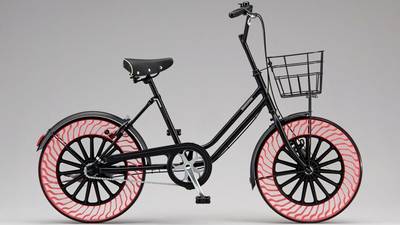
Bridgestone launching 'airless' bicycle tires in 2019
"Pump it up? You won’t really need to, soon. Bridgestone has revealed a new “airless” bicycle tire that it plans to put on sale by 2019. The non-pneumatic features a ring of flexible composite spokes -- connected to a smaller, solid inner hub -- that both hold its shape and provide cushioning on par with an air-filled tube. A conventionally-shaped tread is mounted to the outside. Bridgestone has been developing “tweels” intended for automobiles for several years, but has yet to commercialize any of the designs. Polaris currently sells an ATV with flat-proof tires of a similar design that’s available to military and consumer users, while Michelin offers one for small commercial vehicles. Projected pricing and size availability for the Bridgestone bicycle tires have not yet been determined." [...]

NASA Spacecraft Dives Between Saturn and Its Rings
"NASA's Cassini spacecraft is back in contact with Earth after its successful first-ever dive through the narrow gap between the planet Saturn and its rings on April 26, 2017. The spacecraft is in the process of beaming back science and engineering data collected during its passage, via NASA's Deep Space Network Goldstone Complex in California's Mojave Desert. The DSN acquired Cassini's signal at 11:56 p.m. PDT on April 26, 2017 (2:56 a.m. EDT on April 27) and data began flowing at 12:01 a.m. PDT (3:01 a.m. EDT) on April 27. "In the grandest tradition of exploration, NASA's Cassini spacecraft has once again blazed a trail, showing us new wonders and demonstrating where our curiosity can take us if we dare," said Jim Green, director of the Planetary Science Division at NASA Headquarters in Washington. As it dove through the gap, Cassini came within about 1,900 miles (3,000 kilometers) of Saturn's cloud tops (where the air pressure is 1 bar -- comparable to the atmospheric pressure of Earth at sea level) and within about 200 miles (300 kilometers) of the innermost visible edge of the rings. While mission managers were confident Cassini would pass through the gap successfully, they took extra precautions with this first dive, as the region had never been explored. "No spacecraft has ever been this close to Saturn before. We could only rely on predictions, based on our experience with Saturn's other rings, of what we thought this gap between the rings and Saturn would be like," said Cassini Project Manager Earl Maize of NASA's Jet Propulsion Laboratory in Pasadena, California. "I am delighted to report that Cassini shot through the gap just as we planned and has come out the other side in excellent shape."" [...]
Outras Notícias
- Allegro MicroSystems, LLC Announces a New Family of Low Voltage Precision Hall Effect Latch ICs
- Affordable STM32 Cloud-Connectable Kit from STMicroelectronics Puts More Features On-Board for Fast and Flexible IoT-Device Development
- Microchip Unveils the SAM R30 System in Package for Wirelessly Connected Designs
- 100% 3D Printed Solid Rocket Motor
- MIT Mathematician Spins Up 220,000-Core Google Compute Cluster
Ciência e Tecnologia
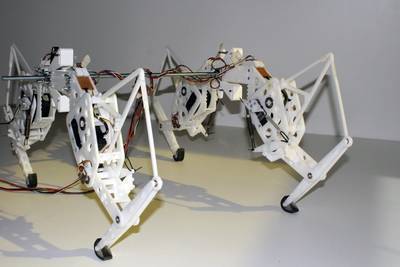
University of Twente researcher Geert Folkertsma has developed a prototype cheetah robot
"Folkertsma has dedicated four years of research and development to constructing a scaled-down robotic version of the fastest land animal in the world, with a view to replicating its movements. Relatively speaking, the robot moves using only about fifteen percent more energy than a real cheetah. Folkertsma’s doctoral defence of this unique project will take place on 21 April 2017 at the University of Twente." [...]

Changing the game
"When Shuaiwen Leon Song boots up Doom 3 and Half-life 2, he does so in the name of science. Song studies high performance computing at Pacific Northwest National Laboratory, with the goal of making computers smaller, faster and more energy efficient. A more powerful computer, simply put, can solve greater scientific challenges. Like modeling complex chemical reactions or monitoring the electric power grid. The jump from supercomputers to video games began when Song asked if hardware called 3D stacked memory could do something it was never designed to do: help render 3D graphics. 3D rendering has advanced science with visualizations, models and even virtual reality. It's also the stuff of video games." [...]

New Quantum Liquid Crystals May Play Role in Future of Computers
"Physicists at the Institute for Quantum Information and Matter at Caltech have discovered the first three-dimensional quantum liquid crystal—a new state of matter that may have applications in ultrafast quantum computers of the future. "We have detected the existence of a fundamentally new state of matter that can be regarded as a quantum analog of a liquid crystal," says Caltech assistant professor of physics David Hsieh, principal investigator on a new study describing the findings in the April 21 issue of Science. "There are numerous classes of such quantum liquid crystals that can, in principle, exist; therefore, our finding is likely the tip of an iceberg." Liquid crystals fall somewhere in between a liquid and a solid: they are made up of molecules that flow around freely as if they were a liquid but are all oriented in the same direction, as in a solid. Liquid crystals can be found in nature, such as in biological cell membranes. Alternatively, they can be made artificially—such as those found in the liquid crystal displays commonly used in watches, smartphones, televisions, and other items that have display screens." [...]

Rechargeable ‘spin battery’ promising for spintronics and quantum computing
"Researchers have shown how to create a rechargeable “spin battery” made out of materials called topological insulators, a step toward building new spintronic devices and quantum computers. Unlike ordinary materials that are either insulators or conductors, topological insulators are both at the same time - they are insulators inside but conduct electricity on the surface. The materials might be used for spintronic devices and quantum computers more powerful than today's technologies. Electrons can be thought of as having two spin states: up or down, and a phenomenon known as superposition allows electrons to be in both states at the same time. Such a property could be harnessed to perform calculations using the laws of quantum mechanics, making for computers much faster than conventional computers at certain tasks. The conducting electrons on the surface of topological insulators have a key property known as “spin momentum locking,” in which the direction of the motion of electrons determines the direction of its spin. This spin could be used to encode or carry information by using the down or up directions to represent 0 or 1 for spin-based information processing and computing, or spintronics." [...]
Not stuck on silicon
"In 2016, annual global semiconductor sales reached their highest-ever point, at $339 billion worldwide. In that same year, the semiconductor industry spent about $7.2 billion worldwide on wafers that serve as the substrates for microelectronics components, which can be turned into transistors, light-emitting diodes, and other electronic and photonic devices. A new technique developed by MIT engineers may vastly reduce the overall cost of wafer technology and enable devices made from more exotic, higher-performing semiconductor materials than conventional silicon. The new method, reported today in Nature, uses graphene — single-atom-thin sheets of graphite — as a sort of “copy machine” to transfer intricate crystalline patterns from an underlying semiconductor wafer to a top layer of identical material. The engineers worked out carefully controlled procedures to place single sheets of graphene onto an expensive wafer. They then grew semiconducting material over the graphene layer. They found that graphene is thin enough to appear electrically invisible, allowing the top layer to see through the graphene to the underlying crystalline wafer, imprinting its patterns without being influenced by the graphene. Graphene is also rather “slippery” and does not tend to stick to other materials easily, enabling the engineers to simply peel the top semiconducting layer from the wafer after its structures have been imprinted." [...]
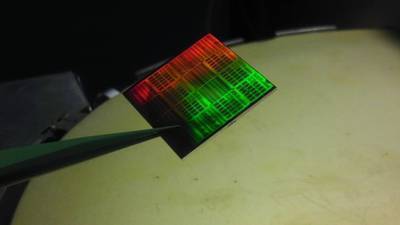
A microprocessor based on a two-dimensional semiconductor
"The advent of microcomputers in the 1970s has dramatically changed our society. Since then, microprocessors have been made almost exclusively from silicon, but the ever-increasing demand for higher integration density and speed, lower power consumption and better integrability with everyday goods has prompted the search for alternatives. Germanium and III–V compound semiconductors are being considered promising candidates for future high-performance processor generations and chips based on thin-film plastic technology or carbon nanotubes could allow for embedding electronic intelligence into arbitrary objects for the Internet-of-Things. Here, we present a 1-bit implementation of a microprocessor using a two-dimensional semiconductor—molybdenum disulfide. The device can execute user-defined programs stored in an external memory, perform logical operations and communicate with its periphery. Our 1-bit design is readily scalable to multi-bit data. The device consists of 115 transistors and constitutes the most complex circuitry so far made from a two-dimensional material." [...]
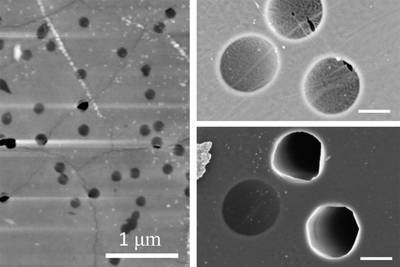
Graphene holds up under high pressure
"A single sheet of graphene, comprising an atom-thin lattice of carbon, may seem rather fragile. But engineers at MIT have found that the ultrathin material is exceptionally sturdy, remaining intact under applied pressures of at least 100 bars. That’s equivalent to about 20 times the pressure produced by a typical kitchen faucet. The key to withstanding such high pressures, the researchers found, is pairing graphene with a thin underlying support substrate that is pocked with tiny holes, or pores. The smaller the substrate’s pores, the more resilient the graphene is under high pressure. Rohit Karnik, an associate professor in MIT’s Department of Mechanical Engineering, says the team’s results, reported today in the journal Nano Letters serve as a guideline for designing tough, graphene-based membranes, particularly for applications such as desalination, in which filtration membranes must withstand high-pressure flows to efficiently remove salt from seawater." [...]
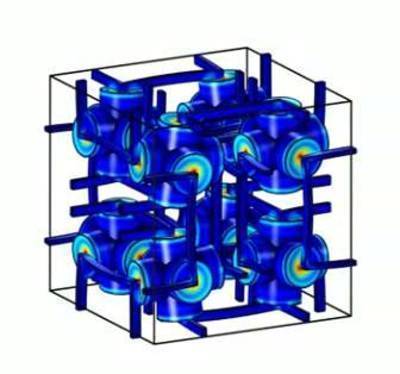
Growth under pressure: New metamaterial designed with counterintuitive property
" In the not-too-distant future, it may be possible to 3-D print virtually anything. Consider standard printers, which "synthesize" thousands of colors by using only three color cartridges. By analogy, future 3-D printers may be capable of synthesizing thousands of different material properties with a mere handful of material cartridges. This concept inspired a group of researchers from the Karlsruhe Institute of Technology (KIT) in Germany and the French National Center for Scientific Research to explore such development of one mechanical property called effective static compressibility. As they now report in Applied Physics Letters, from AIP Publishing, by using a single cartridge it's possible to print a metamaterial which expands in size under hydrostatic pressure, even though it's made up of material which normally shrinks under hydrostatic pressure. In principle, there is no limit to the negative value this material's effective compressibility can take." [...]

New strategy produces stronger polymers
"Plastic, rubber, and many other useful materials are made of polymers — long chains arranged in a cross-linked network. At the molecular level, these polymer networks contain structural flaws that weaken them. Several years ago, MIT researchers were the first to measure certain types of these defects, called “loops,” which are caused when a chain in the polymer network binds to itself instead of another chain. Now, the same researchers have found a simple way to reduce the number of loops in a polymer network and thus strengthen materials made from polymers. To achieve this, the researchers simply add one of the components of the polymer network very slowly to a large quantity of the second component. Using this approach, they were able to cut the number of loops in half, in a variety of different polymer network structures. This could offer an easy way for manufacturers of industrially useful materials such as plastics or gels to strengthen their materials." [...]
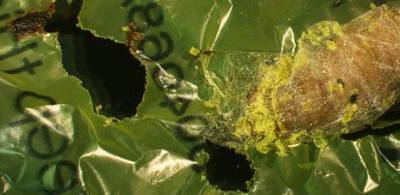
Caterpillar found to eat shopping bags, suggesting biodegradable solution to plastic pollution
"A common insect larva that eats beeswax has been found to break down chemical bonds in the plastic used for packaging and shopping bags at uniquely high speeds. Scientists say the discovery could lead to a biotechnological approach to the polyethylene waste that chokes oceans and landfills. Scientists have found that a caterpillar commercially bred for fishing bait has the ability to biodegrade polyethylene: one of the toughest and most used plastics, frequently found clogging up landfill sites in the form of plastic shopping bags. The wax worm, the larvae of the common insect Galleria mellonella, or greater wax moth, is a scourge of beehives across Europe. In the wild, the worms live as parasites in bee colonies. Wax moths lay their eggs inside hives where the worms hatch and grow on beeswax – hence the name. A chance discovery occurred when one of the scientific team, Federica Bertocchini, an amateur beekeeper, was removing the parasitic pests from the honeycombs in her hives. The worms were temporarily kept in a typical plastic shopping bag that became riddled with holes. Bertocchini, from the Spanish National Research Council (CSIC), collaborated with colleagues Paolo Bombelli and Christopher Howe at the University of Cambridge’s Department of Biochemistry to conduct a timed experiment. Around a hundred wax worms were exposed to a plastic bag from a UK supermarket. Holes started to appear after just 40 minutes, and after 12 hours there was a reduction in plastic mass of 92mg from the bag. Scientists say that the degradation rate is extremely fast compared to other recent discoveries, such as bacteria reported last year to biodegrade some plastics at a rate of just 0.13mg a day. Polyethylene takes between 100 and 400 years to degrade in landfill sites." [...]
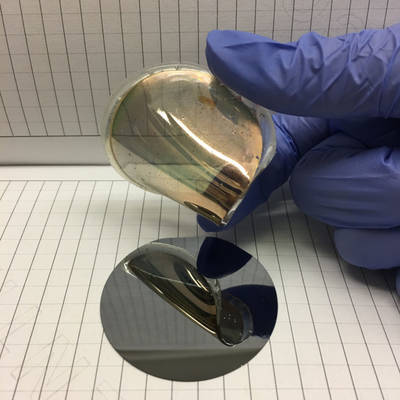
Research leads to a golden discovery for wearable technology
"Some day, your smartphone might completely conform to your wrist, and when it does, it might be covered in pure gold, thanks to researchers at Missouri S&T. Writing in the March 17 issue of the journal Science, the S&T researchers say they have developed a way to “grow” thin layers of gold on single crystal wafers of silicon, remove the gold foils, and use them as substrates on which to grow other electronic materials. The research team’s discovery could revolutionize wearable or “flexible” technology research, greatly improving the versatility of such electronics in the future. According to lead researcher Jay A. Switzer, the majority of research into wearable technology has been done using polymer substrates, or substrates made up of multiple crystals. “And then they put some typically organic semiconductor on there that ends up being flexible, but you lose the order that (silicon) has,” says Switzer, Donald L. Castleman/FCR Endowed Professor of Discovery in Chemistry at S&T. Because the polymer substrates are made up of multiple crystals, they have what are called grain boundaries, says Switzer. These grain boundaries can greatly limit the performance of an electronic device." [...]
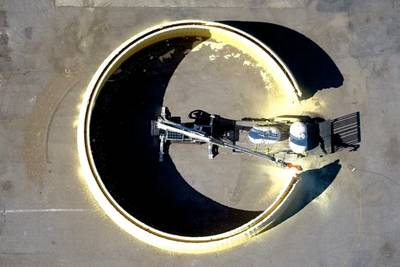
3-D printing offers new approach to making buildings
"The list of materials that can be produced by 3-D printing has grown to include not just plastics but also metal, glass, and even food. Now, MIT researchers are expanding the list further, with the design of a system that can 3-D print the basic structure of an entire building. Structures built with this system could be produced faster and less expensively than traditional construction methods allow, the researchers say. A building could also be completely customized to the needs of a particular site and the desires of its maker. Even the internal structure could be modified in new ways; different materials could be incorporated as the process goes along, and material density could be varied to provide optimum combinations of strength, insulation, or other properties. Ultimately, the researchers say, this approach could enable the design and construction of new kinds of buildings that would not be feasible with traditional building methods. The robotic system is described this week in the journal Science Robotics, in a paper by Steven Keating PhD ’16, a mechanical engineering graduate and former research affiliate in the Mediated Matter group at the MIT Media Lab; Julian Leland and Levi Cai, both research assistants in the Mediated Matter group; and Neri Oxman, group director and associate professor of media arts and sciences. The system consists of a tracked vehicle that carries a large, industrial robotic arm, which has a smaller, precision-motion robotic arm at its end. This highly controllable arm can then be used to direct any conventional (or unconventional) construction nozzle, such as those used for pouring concrete or spraying insulation material, as well as additional digital fabrication end effectors, such as a milling head." [...]

Wireless power could enable ingestible electronics
"Researchers at MIT, Brigham and Women’s Hospital, and the Charles Stark Draper Laboratory have devised a way to wirelessly power small electronic devices that can linger in the digestive tract indefinitely after being swallowed. Such devices could be used to sense conditions in the gastrointestinal tract, or carry small reservoirs of drugs to be delivered over an extended period. Finding a safe and efficient power source is a critical step in the development of such ingestible electronic devices, says Giovanni Traverso, a research affiliate at MIT’s Koch Institute for Integrative Cancer Research and a gastroenterologist and biomedical engineer at Brigham and Women’s Hospital." [...]

New Self-Sustained Multi-Sensor Platform for Environmental Monitoring
"A recent study, affiliated with UNIST has engineered a self-sustaining sensor platform to continuously monitor the surrounding environment without having an external power source. This research has been led by the team of Professor Jaehyouk Choi of Electrical and Computer Engineering at UNIST in collaboration with Professor Wonjoon Choi of Mechanical Engineering at Korea University. The findings, published in the March issue of the prestigious journal, Nano Energy note that the proposed platform is expected to contribute to advanced sensing functions of a self-sustaining system for various targeted-ambient elements. In the study the research team presented a self-sustaining water-motion-sensing (SS-WMS) platform to monitor and display the time-varying dynamics of water-motion, such as frequency and amplitude, using only the energy harvested from the water-motion itself. A self-sustaining sensor platform is a core component for Internet-of-Things (IoTs) and smart-grid systems. The existing sensor platforms require energy to operate and display the detected information. Therefore, monitoring, processing, and displaying the minute changes of a targeted-environmental element in a real-time fashion without the use of external power sources or energy storages, like batteries has been challenging. The research team solved this problem with the use of energy harvesting, an essential technology for permanent sensor platforms. Energy harvesting, also known as energy scavenging, is a technology for the harvesting of energy from various sources in the ambient environment, such as wind, water, light, heat, and mechanical energy for conversion into convebient use electric energy." [...]
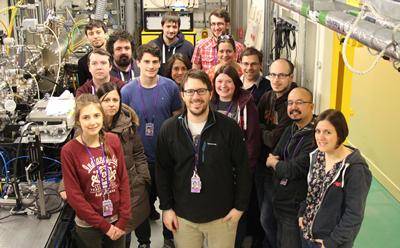
Scientists unlock ‘golden’ secret to help boost PVC industry
"A University of Southampton scientist has helped unlock the secret of a gold-based catalyst used to produce a key component of polyvinyl chloride (PVC) – the world’s third most widely used plastic. Dr Peter Wells, lecturer in Inorganic Chemistry, was part of an international group of scientists who examined the production process behind the vinyl chloride monomer (VCM) used to make PVC. PVC has become an indispensable part of modern life. Its applications include construction pipes, credit cards, window and door frames, plumbing equipment, and electrical cable insulation. China is the world’s biggest producer of VCM, making 30 million tons a year, and recently replaced the conventional production process, which used a potentially toxic mercury-containing catalyst, with a more environmentally friendly gold-based catalyst. China is the first country to produce VCM on an industrial scale using this catalyst – but until now it was not fully understood how it worked. The researchers found that the active catalyst was made up of individual atoms of gold spread out on a carbon surface. The gold also needed to be present in an ionized form – meaning that some of its electrons are missing – in order to convert acetylene, a gas derived from coal, to the VCM molecules that can then be linked to form PVC." [...]

Finally, a peek inside the ‘black box’ of machine learning systems
"Many astounding feats of computer intelligence, from automated language translation to self-driving cars, are based on neural networks: machine learning systems that figure out how to solve problems with minimal human guidance. But that makes the inner workings of neural networks like a black box, opaque even to the engineers who initiate the machine learning process. “If you look at the neural network, there won’t be any logical flow that a human can understand, which is very different from traditional software,” explains Guy Katz, a postdoctoral research fellow in computer science at Stanford. That opacity can be worrisome when it comes to using neural networks in safety-critical applications, like preventing aircraft collisions. Running hundreds of thousands of successful simulations isn’t enough to inspire full confidence, because even one system failure in a million can spell disaster." [...]
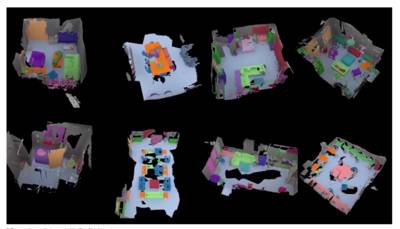
A Massive New Library of 3-D Images Could Help Your Robot Butler Get Around Your House
"For a robot to be of any real help around the home, it will need to be able to tell the difference between a coffee table and a child’s crib—a simple task that most robots can’t do today. A huge new data set of 3-D images captured by researchers from Stanford, Princeton, and the Technical University of Munich might help. The data set, known as ScanNet, includes thousands of scenes with millions of annotated objects like coffee tables, couches, lamps, and TVs. Computer vision has improved dramatically in the past five years, thanks in part to the release of a much simpler 2-D data set of labeled images called ImageNet, generated by another research group at Stanford. ScanNet would contribute even more data for the mission. “ImageNet had a critical amount of annotated data, and that sparked the AI revolution,” says Matthias Neissner, a professor at the Technical University of Munich and one of the researchers behind the data set. The hope is that ScanNet will give machines a deeper understanding of the physical world, and that this could have practical applications. “The obvious scenario is a robot in your home,” Neissner says. “If you have a robot, it needs to figure out what’s going on around it.”" [...]
Modelos 3D
Com a disponibilidade de ferramentas que permitem dar azo a nossa imaginação na criação de peças 3D e espaços como o thingiverse para as publicar, esta rubrica apresenta alguns modelos selecionados que poderão ser úteis.
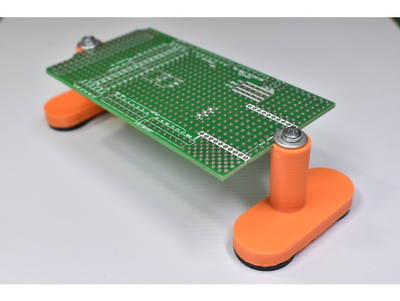
Simple PCB Holder
"Big and heavy PCB Holders are bulkier and harder to use. With this gadget i can easily do my soldering work on my table. Use M3x30 screw, nut and washer." [...]
Projetos Maker
Diversos Projetos interessantes.

PIX-E Gif Camera
"I was asked by my friend Matt Griffin to make a project for World Maker Faire 2016 and we landed on a gif camera. My thought process was that I wanted to create a camera that recalled those days when disposable cameras were a thing. Anyone with intermediate making/printing/coding skills should be able to put this together pretty easily." [...]
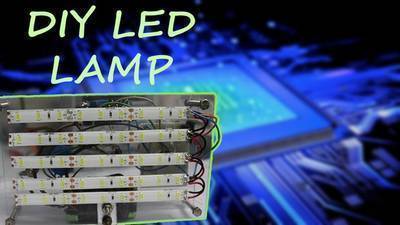
DIY LED Lamp
"In these 3 years I was full of things to do which took me a lot of time. Last month I decided to come back on Instructables. So I decided to collab with my friend Riccardo, that shares my same passion, to come back publishing Ible. Together we decided to start a Youtube channel and change the profile name in DIY Brothers." [...]
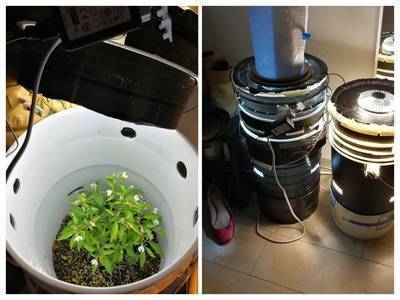
Grow Anything Grow Bucket for $50
"Normally when you grow indoors you can only grow shade resistant plants. But with the lights and fan mounted on this bucket, you can grow pretty much anything! Pictured is my Thai hot chili plant. This project is heavily based on the DIY Space Bucket build, with some minor modifications so that you don't have to fiddle with any wires (the electronics just plug into each other). If you just want to buy a kit, sign up for my newsletter! http://growbucket.life I will be selling 100 kits at Maker Faire Bay Area (http://makerfaire.com/bay-area/) for $50 each in May, and I'm dreaming of doing a Kickstarter for a version of this with LED lights to save power. Because I'm making 100, I have been able to buy some of the parts at great bulk rates, bringing my total cost to $30 (not including tax), but if you buy just the parts for 1 grow bucket kit your cost will be about $50." [...]
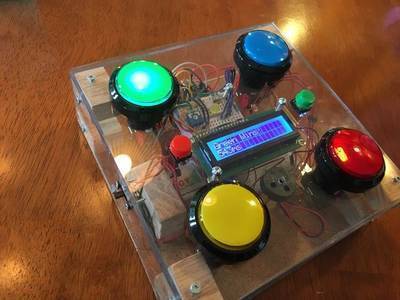
Arduino Fastest Reaction Time Game for 1-4 Players
"The official Arduino starter kit with tutorials is a fantastic way to learn the basics and all the of the various things you can do and I can't recommend it highly enough. But once I had gone through making LEDs blink, buzzers buzz, and motors turn I thought about how I could turn that into something my kids and I could enjoy playing with, and this is the result: a fun, fully featured and functioning 4 person fastest reaction time game. This game can be built using nothing but parts from the Arduino starter kit. This tutorial includes an optional 74HC595 chip (a very common and inexpensive integrated circuit available in almost any expansion pack or on their own) that can be omitted without much impact on the final result. This will be explained in more detail in the steps." [...]
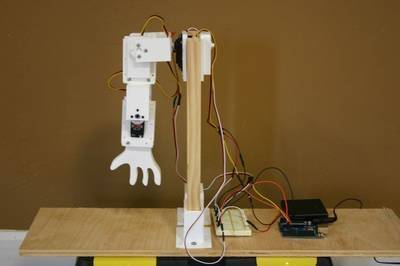
Robot Servo With Idle Horn
"The purpose of this instructable is to provide a "shell" that can be used to convert a common servo motor to a robot servo with an idle horn. The idle horn (opposite the main drive horn) spins and allows easy connection of a C joint. When I built Santa's Shop, I had 32 robot servo motors (with an idle horn opposite the main horn) in the animatronic figures and they had to operate 4 hours per day for about 35 days. Two of them failed during the season, while there were no failures in my creations using cheapo servos. For this project, I used my "shell" on three servo motors and built an arm." [...]
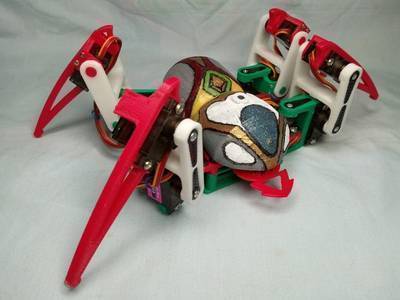
Spider Robot(Quad Robot, Quadruped)
"This is my first project for the 4 legs robot and it took me about 1 year development. It is a robot that relies on calculations to position servos and pre-programmed sequences of legs. I'm doing this by handmade way is because of it could be fun and educational for 3D design/printing and robot control. This is the fourth generation of my design, you can take a look here if you are interested the history." [...]
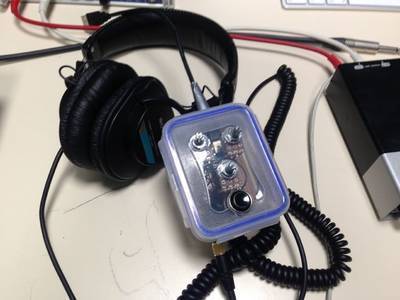
Reprogrammable Arduino Synthesizer
"This tutorial makes up part of the portfolio submission for a creative research project based around DIY instrument builders and online DIY communities that I undertook in the final year of my BA. The aim with this build was to provide a bridge between a number of open source software and hardware platforms. I designed it with musicians and artists in mind who may have some experience in DIY electronics and who wish to consolidate this knowledge by building an instrument with real functionality that can be easily expanded upon. This tutorial will show you how to build a simple synthesizer from start to finish using an Arduino nano, the MOZZI audio library for Arduino and a few common electrical components. I have provided two different programs that you can upload to the Arduino to get two different sound engines. I would love it if people started to experiment with the code and build their own synthesizer engines for the hardware." [...]
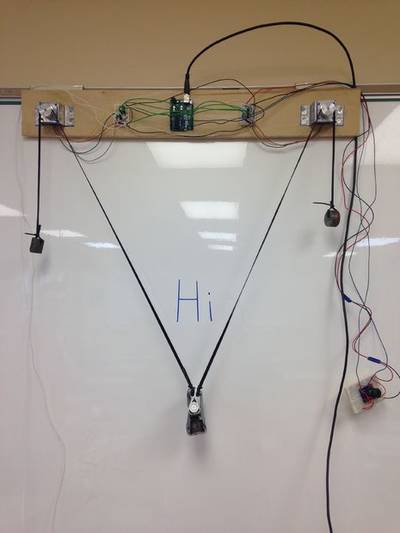
SIMPLEST Arduino Vertical Plotter
"We made a simple "proof of concept" vertical plotter out of things that we found lying around, two stepper motors, and an Arduino! You could probably make it too, by following these simple steps." [...]

Simplest ESP8266 Local Time Internet Clock With OLED
"I was looking for a straightforward clock to use with a 128x64 OLED I got from Adafruit but found that a lot of the implementations were too cumbersome, involved a ton of code, weren't clear on what NTP servers to use and how, and basically offered very little in terms of making a clock with the LOCAL time (not UTC, which is easy enough to get). So I set about doing my own research and ended up with this simple clock that leverages already made libraries to minimize the code footprint, while offering some interesting tweaks in displaying the time (like AM/PM, 12-hour format, names for months, days, etc). This instructable assumes you have some experience programming ESP-01s but if not, there are a ton of wonderful tutorials available on Instructables! Enjoy!" [...]

Programming Digilent FPGAs Using NI Multisim
"Whether you just like to tinker in your garage or you work with them professionally, knowing how to use and program FPGAs is a definite plus for anybody. The problem is that every company that makes FPGAs has their own proprietary software that you have to have in order to use the FPGA board. Luckily National Instruments has made it possible to program many Digilent FPGA boards without having to leave the familiar and ubiquitous Multisim environment. It takes some work to do the initial set up, but once everything is all set up correctly, you'll be programming FPGAs in no time." [...]
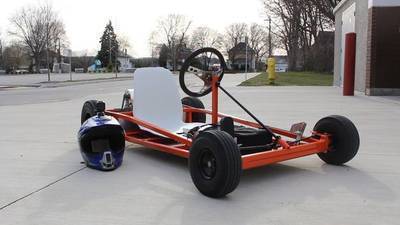
How to Make an Electric Go Kart
"In this Instructable I will be showing you how I transformed an old gas powered go kart into an electric go kart. This project was very time consuming and I am very happy to finally share it with all of you! The hardest part of this project was definitely searching for all of the parts and overcoming issues along the way. This go kart is loads of fun to drive around town and with the current sprocket set up it can go around 50kph! Before you go through the rest of the steps for this project, you should definitely watch the video that I have posted below. The video will show you plenty of clips of me building the go kart from start to finish and you will also be able to see my drive it! Also, if you enjoy the video you should definitely hit the like button or even consider subscribing to my YouTube channel. Most importantly don't forget to follow me here on my Instructables page so that you can see all of my future projects! Let's get started with this project!" [...]

Led Cube 5x5x5 (Arduino Project)
"In this project I will show you how to build a simpler version of a 5x5x5 LED Cube. I’m providing a full step-by-step guidance to show you how to make your own LED Cube, and I explaining in details both hardware and software parts in order to turn this guidance the simplest way that leads you to try your own skills in electronic making. This project is so handy to make specially after getting the customized PCB that we’ve ordered from EasyEDA to improve the appearance of our Cube and also there is enough documents and codes in this guide to allow you create customized animations and some bounce display movements. If you dislike to read so much! You can watch this video for more clear guidance." [...]
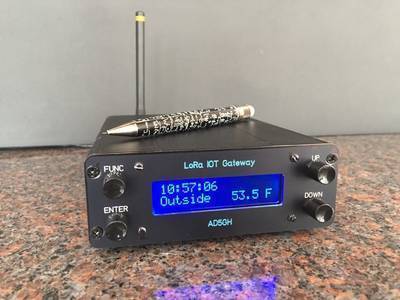
LoRa IOT Home Environment Monitoring System
"The LoRa IOT Home Environmental Monitoring System consists of an Arduino Mega based IOT-to-Internet gateway and Arduino Feather based remote stations with environmental sensors. The remote stations communicate wirelessly with the gateway using LoRa radios. The system enables a homeowner to monitor the home environment via an internet accessible dashboard, receive periodic SMS environmental notifications, receive realtime SMS alerts when monitored environmental parameters exceed preset thresholds, and log environmental data to the cloud. As a homeowner, other than fire, the greatest fear is water, whether it's a sudden and catastrophic pipe or fixture failure, or a slow leak that goes undetected over time. If you are away from home when a sudden and catastrophic event occurs there may not be much that can be done, however, returning home sooner rather later or calling a neighbor due to humidity readings suddenly spiking could mitigate the damage. A slow leak can be more insidious, potentially resulting in structural damage and black mold. The LoRa IOT Home Environment Monitoring System monitors household humidity levels over time and provides insight to how normal humidity levels fluctuate throughout the year with changes in outdoor humidity, and daily with normal household activities such as clothes drying, showers & etc. Armed with this knowledge, high humidity thresholds can be intelligently set for the various remote stations enabling the LoRa IOT Home Environment Monitoring System to send an alert when abnormal humidity readings are detected. SMS alerts and hourly updates appear on a smart phone Lock Screen so are immediately available without requiring an application to be launched or browsing to a dashboard. The LoRa IOT Home Environment Monitoring System is built using readily available hardware modules and a few individual components such as switches and connectors. The parts for the system can be obtained from Adafruit, Digikey and Sparkfun; in many cases, Adafruit and Sparkfun parts are also available from Digikey. Competent soldering skills are needed to assemble the hardware, in particular to solder SMT uFL connectors to the LoRa radio breakout and Feather boards. The Arduino code is written in a procedural style and liberally commented to allow easy extension of functionality." [...]
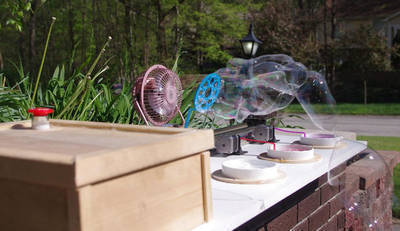
Arduino Powered Three Arm Bubble Machine
"Some time ago I liberated several ball screw linear rails from the scrap bin at my workplace. I used four of them to make a CNC router. I gave a few away. I have one left. So what to do.... What to do... MAKE A BUBBLE MACHINE!!!! There are many home made bubble machines out there, so I wanted to create something different using the ball screw slide. Therefore what I envisioned is an Arduino version of the old I Love Lucy candy packaging skit but as a bubble machine. So the concept was multiple bubble wand raising and lowering in a random fashion. Connected to the ball screw slide is a fan. When the wand is raised and ready for blowing, the ball screw positions the fan in front of the wand and blows the bubbles. After set time of blowing bubbles, the wand lowers to recharge with bubble solution and the ball screw slide moves to the next available ready to blow wand. I wanted this machine to be erratic in behaviour with the wands moving randomly and the ball screw slide furiously trying to keep up. So on with the build..." [...]
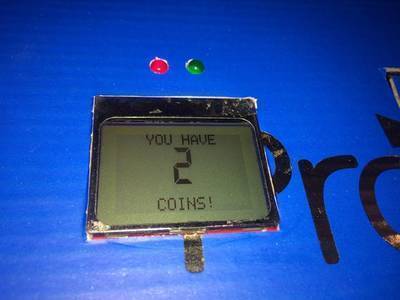
Arduino Smart MoneyBox
"Welcome friend, today we are going to make Smart Moneybox with Arduino. We want to; When we drop the money onto compartment, device open the door after 3 seconds. Finally close the door. And count the how many coins in to the box." [...]

Electric Bicycle (EBike) Dashboard and Battery Monitor
"This project is an Arduino circuit that monitors battery voltage and current with an ACS 712 module. The measurements are communicated over Bluetooth with an HC-05 module to an Android device. Basically you rewire the negative connection between your controller and battery to go through the ACS712 module. The Android app displays the battery status as well as current speed and distance traveled from the Android GPS The Android can be mounted to the bike in a weatherproof bag. The Arduino circuit is permanently mounted in a weatherproof box on the bike near the battery." [...]

Raspi EDLC UPS
"For the Rundbuntplasma I wanted that the main power supply (a big 20A/5V supply) could be hard disconnected (aka operating the main power switch in our hacker space) from mains and the Raspberry will still shutdown nicely automatically. The idea is to buffer the 5V for the Raspberry using two big Supercapacitors (EDLCs) with 50F each from Nesscap. The circuit was designed to be as simple as possible, the drawback is that the capacity is not used efficiently and has only enough time for a proper short shutdown (about 30 seconds). Another drawback is that the power supply comes up slowly at startup (takes about 10 seconds before Raspberry starts booting) and also powers the Raspberry for quite a long time after the shutdown so the system must be unplugged for about 10min before it will boot up again. But there main advantage over batteries is the lifetime of supercaapacitors: They can be charged and discharged completely a few 100.000 times and are quick to charge - after ~2min they carry enough charge for proper shutdown." [...]
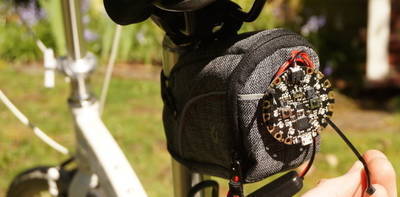
Circuit Playground Bike Light
"In this guide we will use our Circuit Playground to create a customizable bike light. We'll look at how we define colors in code and use that to make some fun animations with the NeoPixels. We'll provide some example animations you can customize. Or you can modify and adapt the examples to try and create your own. In a world of blinking red bike lights, add some color and pizazz to stand out!" [...]

Snake Robot
"Introducing The Lake Erie Mamba: a Reconfigurable Robot Snake. This versatile reptile is made with off-the-shelf parts and is capable of several different modes of locomotion, including slithering, inch worm, sidewinding and rolling. (The rolling configuration involves the snake curling itself into a vertical loop and rolling like a wheel. See the last section in the video above.) The snake contains 12 segments actuated by servo motors and joined with metal brackets. The servos are controlled by an Arduino Mega and powered by a 7.4 volt battery pack. A four button keyfob transmitter provides remote control for the snake. The snake is also capable of autonomous movement. Such a robot can be constructed with many different types of servos and brackets. If you decide to give one a try, I hope you find the code given below to be useful." [...]
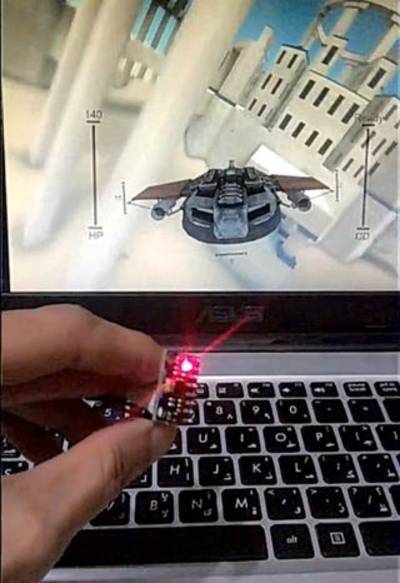
Create Your Own VR Game Controller Using Arduino
"If you are a gamer and a hardware geek at the same time, you obviously know how hard it can be to choose how to spend weekend, playing games or making cool hardware. This project will give you heaven of the both worlds! We will create an Arduino based game controller which detects motion which works as a great controller for VR games. But it's not limited to VR, it can be used to play any supported PC, XBox or PlayStation game." [...]
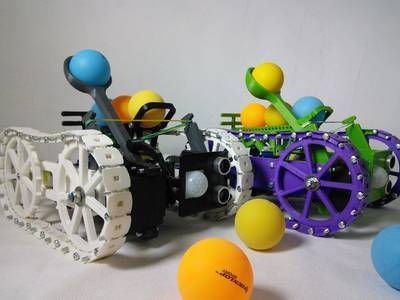
HOG, BT Controlled Robot
"In these instructables we will show you, how to make 3d printed tank with catapult. We were working on this project more than 500 hours, and we will keep updating it with better versions. We named it "HOG". You can use our tracks for any project, catapult is only an add-on, and you dont need to print one, if you only need them. But this is not regular catapult - it is semi-automatic. It fires ping pong balls and can reload 3 times. Its range is somewhere around 3 meters. We used three servo motors, to achive that. It is powered by two 18650 batteries. We are using arduino NANO microcontroler. To make it easy to control and drive, we made app, wich you can download to your Android device. You can connect to HOG by Bluetooth. In next steps we will show you how to assemble, program and drive HOG. We draw it in two different programs, Fusion 360 and Solid Works to see the difference between them." [...]
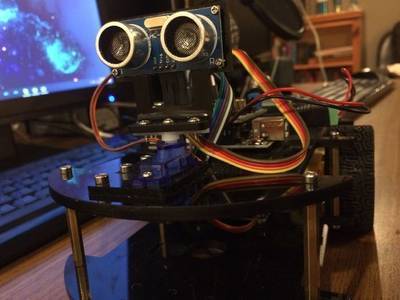
Alfred V.1 - Voice Controlled, IoT, Bluetooth, Servant Robot Using Arduino and Raspberry Pi
"In this tutorial, I'll be showing you how to make Alfred - the Arduino servant robot that uses Alexa-powered voice control on Raspberry Pi over a Bluetooth connection. It sounds really complicated, but it's a great way to learn about microcontrollers, electronics, circuits, bluetooth, Linux, the internet, and programming. Also, it's a great way to learn about something while: 1) not being entirely bored; 2) making something that you can show off to people and make them think you're smart. Additionally, unlike other tutorials that use voice control there's no port forwarding required (you don't have to open up your computers to the internet and hackers), and you don't have to pay for services (the voice control and software are all free)." [...]

Arduino Toolboxes : PWM Frequency Meter
"Lets Make Simple Things Look Beautiful , It Doesn't Need To Be Plan Text Number Of The Boring Font At The LCD Because It Shows The Freq . Most Of Us Specially Me While Working With electronics Need Something To Tell Us What Is The Frequency Of Square Wave Or PWM Signal In A Board , Specially When You Are Fixing It "Electronics hardware Maintenance Will Understand Exactly How This Is Important". In This Project We Used The Digital Clock Version 2 Fonts For Numbers That Was Created For The Clock And Used It In This Project To Display Numbers In This Way. This Project Uses Interrupts To Get Accurate Time Reading , Also Used Math.h Library For Inf Case , And TimerOne Library For Display Values Every Sec For More Stable Reading On The Display. We Used INT0 "Pin 2 In Arduino" As An Input Interrupt And As A Test I Used PWM Pin In The Arduino As Input." [...]
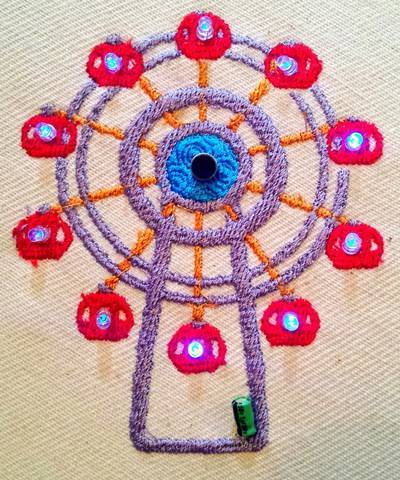
Sound Activated LEDs in Embroidery Using an ATtiny85
"I love embroidery and electronics! This project’s goal was to create sound activated, embroidery embedded LEDs using an ATtiny85! My first step was to find a schematic and code that worked! I found on Technoblogy, a great resource for Arduino & AVR projects. I tested it out on a breadboard, successfully! I like to use ATtinys because you can program them with Arduino code and Sparkfun’s AVR programmer make it very easy!" [...]

Thirsty Tweeting Office Plants
"Here at Andium we're super excited to have finally moved into our new office space. We've been decking it out with walls covered in whiteboards, new shiny tech, and all the comforts of home. It especially started to feel like home when we placed a handful of these green leafy friends throughout the space! We're an IoT company, we're better than this. How come our plants aren't internet connected! Hopefully before it's too late for this little guy I put together a solution using our anduinoWiFi shield and IFTTT. Time to give our plants a voice! If you've got a green thumb you've probably already stopped reading, but if you're like me and need to give your plants the ability to digitally beg for mercy and scream for some water then you're in the right place. To give your plants a voice you'll need an Arduino Due, or Zero, an anduinoWiFi shield, (or any other WiFi connected Arduino that can speak to Adafruit IO) and lastly a 'Capacitive Soil Moisture Sensor'. Oh, and a glass of water. (Give it to your plant when we're done, they'll thank you via e-mail now)" [...]
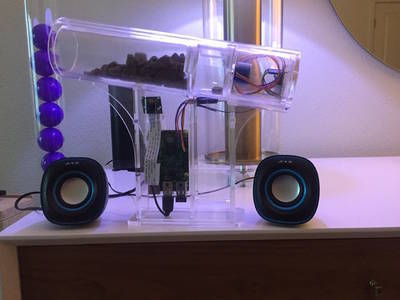
Next Gen Treat Dispenser (Motion Detection, Video and More)
"Do you miss your dog while at work? Or do you love someone who does? This could be a great present for yourself or that special someone in your life who has a furry friend but isn't always with him/her. Here is next generation treat machine, this one with much more flexibility than others I've seen, including motion detection system (e.g. to identify if the dog is home or away, to make sure any video captures the real action); Real time MQTT server allows for easy extension of the treat machine into a series of interactive toys for your dog and / or games you can play remotely with your furry friend; real time dispensing of treats from anywhere in the world. Flexibility to allow for very differently sized treats. You'll soon see another Instructable on how I used this platform to easily build a ball launcher / catcher that gives Pickles treats when he successfully completes the mission of returning the ball." [...]

Mobile Weather Sensors Using ESP8266
"Mountain Biking in the local trails in my Southern California home has kept me both reasonably fit while maintaining a close connection with nature. As you roll through many of the trails here, the terrain varies significantly…from the darker shadows of the canyon floors to the wide-open sun exposed ridge-top fire roads. And with these changes there are noticeable variations in the temperature and moisture in the air. So I got to thinking. Wouldn’t it be interesting to track these variations as the trail climbs up the mountain face and descends down the other side? Sure, there are gadgets available that do this kind of thing. Like tracking your position, speed, altitude and heart-rate. If you really look around, you might even find one that reports the temperature. Not cheap, but they are available. Hmmm… Let’s see, can we make a do-it-yourself alternate? A solution that is much cheaper than the cost of a commercially bought product? This looked like a perfect task for the super low-cost ESP8266 and a few inexpensive sensors. Coupled with a data link to a smartphone, you got a mobile platform tailored to track just about anything. A system that can be tailored to your exact needs. All at a fraction of the cost of a commercially available product, if you can find one meeting the specifications you want. Here is what I came up with. My initial design simply collects data samples and saves them to a file on my Android SD Card. This file is then transferred to a PC for visual representation with excel. Later, I intend to add screens to the Android App to display the data on phone. But first, a data collection and storage system was needed. After thinking about how I wanted to implement these features, the project was broken down into several phases. This post addresses phase 1. Yep, this project is “work-in-progress” and phase 1 is as far as I have gotten…so far. Check back to this blog soon for updates that cover the subsequent elements of this Application as they are developed. Once completed, the “phases” that following will be turned into links." [...]
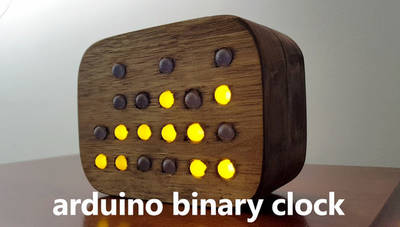
Beautiful Arduino Binary Clock
"In this Instructable I'll be showing how to make a Aduino Binary Clock. Starting with this you can make a binary clock with any design and format as you like, just like any other clock." [...]

Bike Speedometer
"I went to an REI garage sale a few weeks ago, and I picked up an awesome $50 bike speedometer for only $5! I often bike with a group of friends, and it is cool to see my speed in real time. It would be awesome if they could do the same, but none of us want to pay full price. This is what motivated me to try to make my own." [...]
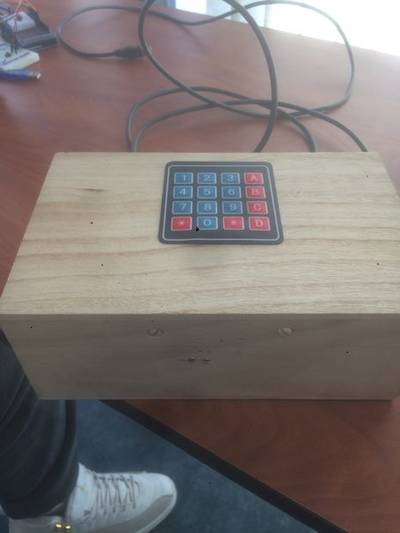
LockBox
"This is a step by step procedure to create a lockbox with arduino. The arduino stores a modifiable password and when it is inputted will rotate the servo mechanism." [...]
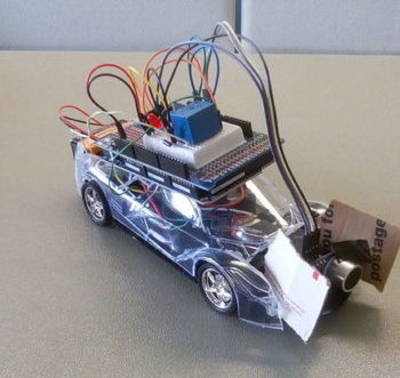
Safety First RC Car
"Build a RC car that uses ultrasonic sensor to detect objects in front of it. And cuts power to the forward motion when reaches a certain distance from an object (specified in code) while retaining the ability to move backwards." [...]
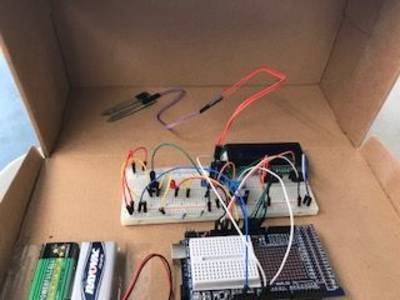
Home Garden Monitoring System
"This is a system that allows you to monitor the soil moisture percentage, as well as the temperature and humidity in the air. It is fairly simple and cheap to build." [...]

ElecTrumpet (Arduino)
"I had seen a project on here before to make a sort of trumpet with an Arduino by rigging up three buttons, but its range was limited and it couldn't play sharps or flats. This design uses a joystick to allow for different ranges that can be reached by tightening one's lips when using a real trumpet. By using only the X-axis on the joystick, the range is from C3 to G4, including sharps and flats. In theory, by using both axes, the range can be expanded further, but I'd rather keep things simpler and easier to understand." [...]
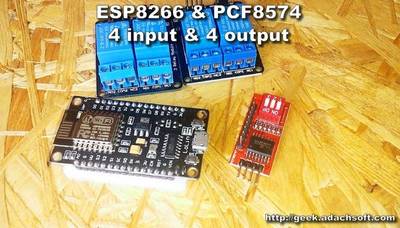
How to Use ESP8266 With PCF8574 - 4 Input and 4 Output
"How to increase the number of I/O pins on the ESP8266 using the PCF8574. This example will use four buttons (as inputs) and four relays (as outputs) and only one PCF8574 chip. The four pins of the PCF8574 chip will be set as inputs and four pins as outputs. In this example I will use NodeMCU but it works well on ESP8266-01. In this tutorial I will also show you, how to use jQuery AJAX with ESP8266. The software for the ESP8266 was written in the Arduino IDE. NodeMCU, ESP8266 is a very good solution for IOT (Internet of things)." [...]
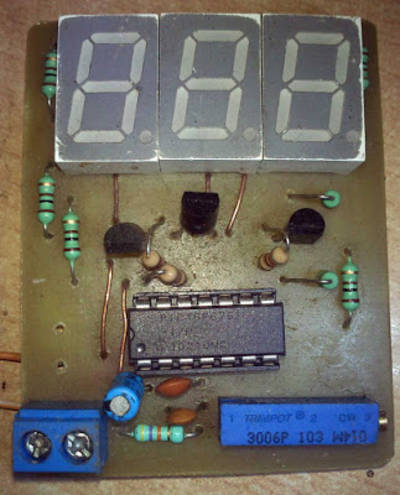
Home made 30 volts Panel Volt Meter Using PIC MCU
"Everyone knows that PIC microcontrollers are still very popular due to its cheap price, user friendly, simple package, and its uncounted applications. One of the major application of PIC16F676 is its internal 10-bit ADC(analog to digital converter), this option helps us to convert our analog data in to digital format in a easy way. In this project we use PIC16F676 microcontroller to design a 30 v DC meter. After successful completion of this project you would be able to use this panel in various systems to measure its output or input voltage. Everything is clear in Schematic diagram. Do a proper wiring for 7 segment LCD. You can easily adjust its accuarcy by changing a values of 47K resistor and 10k trim pot. " [...]

Make a DIY Automatic Irrigation System with Arduino
"In this project, we are going to make an automatic irrigation system that will sense the moisture of the soil and open or close the valve according to it. The moisture value and the valve status will also be shown on the Nokia 5110 LCD. If you’d like to know more about using the FC-28 soil moisture sensor, check out this tutorial: DIY Soil Moisture Testing with Arduino." [...]
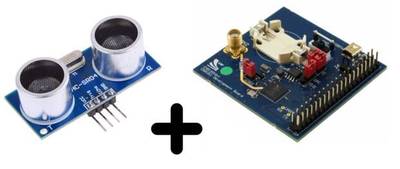
CSR1011 - Using Ultrasonic Sensor
"The CSR1011 is a single mode Bluetooth Smart chip and this tutorial show how to access its GPIOs and read the values of a ultrasonic sensor." [...]
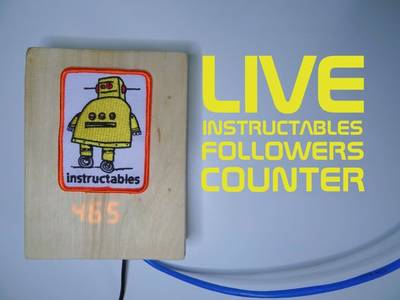
Live Instructables Followers Counter
"Hi! Some time ago I saw this project, it is pretty awesome and you should check it out. I liked it but, my youtube channel is not so popular (at least not yet :D) and I wanted to display other data than just YT subscribers. Bekathwia used in her project youtube API which make getting subcibers views and some other info very simple. And what if I want to display info from other pages (like instructables, instagram, or my own website). I thought that with very basic and short PHP script we can get those information from any website even if there is no API for it. Then using arduino and ENC28J60 we can get this information form server. Of course the biggest downside of it is that we need a server to handle this PHP script, but don't worry I will show you some free hostings. Because I like Instructable so much I decided to make live counter of instructable followers. Additionally because I always wanted to make some woodwork I decided to make like my own frame for it. In this project we will use ENC28J60 ethernet module which is very simple and great to deal with. The biggest advantage of this module is that you don't need to change any password, or username to your WI-FI, you can just plug it in and enjoy your counter. So when you change your router or password to it you don't need to worry about reprogramming your arduino. That's the perfect project for begginers not only with arduino but also with woodworking and soldering!" [...]

Graphic Programming Obstacle Avoidance Robot
"The purpose of this project is to build an obstacle avoidance robot without further knowledge of Arduino programming. Let's get rid of Arduino coding, learn and make an obstacle avoidance robot by using Scratch3.0 based software within two hours. This project is a perfect fit for beginner. If you are interested in fun projects but lack of programming skills, let's start it from here now!" [...]
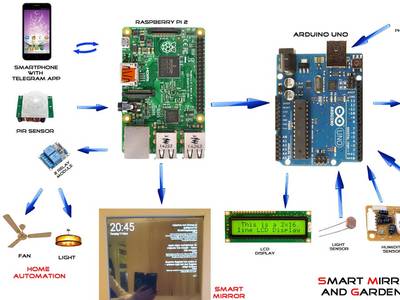
Smart Mirror with Home Automation using chats
"The project Smart Mirror with home and garden automation describes the design and development of a futuristic smart mirror that represents an unobtrusive interface for the ambient home environment with automation using Raspberry Pi. The mirror provides a natural means of interaction through which the residents can control the household smart appliances and access personalized services. Emphasis is also given to ensure convenience in accessing these services with a minimum amount of user intervention. The smart mirror functionalities have been demonstrated by developing an easily extendable home automation system that facilitates the integration of household appliances and various customized information services like live custom wallpaper display. Even more, all the appliances connected to this device can easily automate with the online remote chats through telegram. This creates the mirror with more utilities using Raspberry Pi." [...]
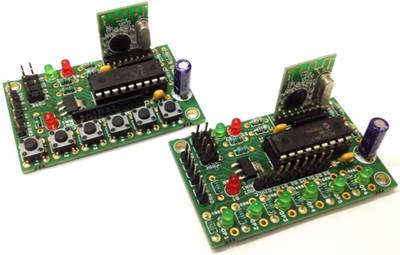
6 Channel RF Remote Controller Using CC2500 RF Modules
"The 6 Channel RF Remote Controller designed using CC2500 RF Transceiver modules and PIC16F1847 micro-controller from microchip. Transmitter provided with 6 tact switch, 4 Address Jumpers to pair multiple unit so they don’t interfere with each other. Board provided with power LED, valid transmission LED. Project works with 5 V DC, On board LM1117-3.3V regulator for CC2500 Module. Two in one PCB can be used as Transmitter & Receiver. Receiver works with 5V DC. 4 Jumper to paring RX& TX units, valid signal LED, power LED, and 9 Pin connector for outputs. Same PCB is used as transmitter and receiver. All outputs are Latch Type and TTL 5V Signal for easy interface with other devices like Relay Boards, Solid State Relays." [...]

Sky Control V1 - Temperature and Humidity Controller With Relays
"This intructable will teach you how to make very cheap Sky Control module (temperature and humidity controller). All the parts cost below 10$. The module is based on Arduino Uno. It uses a DHT22 sensor to measure temperature and humidity. The results are displayed on LCD Screen and pre-sets can be changed by using buttons. By using 2 relays you are able to connect any humidifier and heating element up to 2.5 kW. In this project devices connected to relays should have separate power source (even for 5V heating plate and humidifier that I’m using in my terrarium). In next project I will add Dust Sensor for controlling Air Pollution" [...]
That's all Folks!


